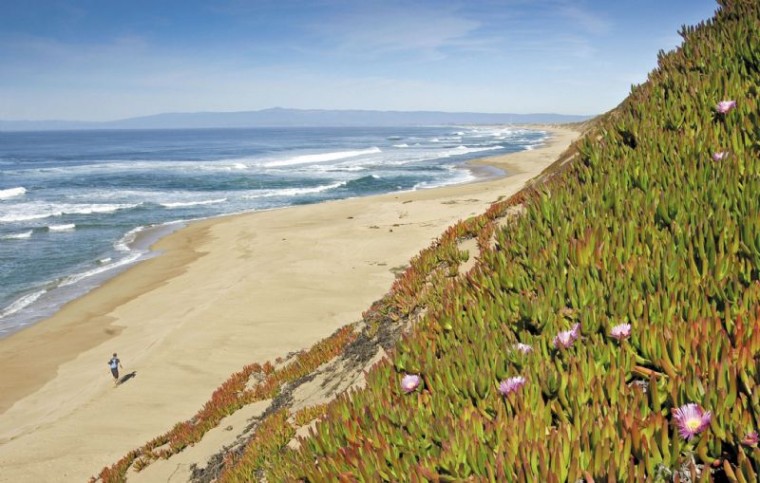Getting Out: California is famous for its beaches. You know the
ones: Frankie Avalon and Annette Funicello at Malibu with the gang.
But on those beaches, it is often hard to find a patch of sand
large enough to unfurl your beach towel. If you want to walk for
miles alone on a beach, you have to head for some distant tropical
island. Or do you?
California is famous for its beaches. You know the ones: Frankie Avalon and Annette Funicello at Malibu with the gang. But on those beaches, it is often hard to find a patch of sand large enough to unfurl your beach towel. If you want to walk for miles alone on a beach, you have to head for some distant tropical island. Or do you?
In February 2009, the federal government deeded 979 acres of Fort Ord land to the state. That includes four miles of the loveliest and loneliest beach you will ever see. This transfer of land and the creation of Fort Ord Dunes State Park were contemplated prior to the fort’s closure in 1994, but access was delayed until completion of a long cleaning process that removed munitions and other military hazards.
It has been more than a year since a friend told me about this park. On recent trips past Fort Ord, I looked for a sign or some evidence of a state park without success. Last week, I decided to end the mystery. Google to the rescue.
On my weekday visit there, it was easy to understand why this park is a “secret.” Even though I printed directions, I had to navigate carefully to get there. The route was roundabout, and the signs pointing the way were easy to miss. Ironically, when I arrived in the parking lot, I was little more than a chip shot away from Highway 1, but utter solitude was just steps away.
The newness of this park is evident as you pull into the parking lot. In fact, crews were there working on the lot when I arrived. One of the nearby information panels points out the parking area was the former site of Stilwell Hall. Built in the 1940’s, the hall was a plush recreation retreat for enlisted men that featured first-class entertainment like Bob Hope and many big bands of the era. The panel also mentions that half of the building pad of Stilwell Hall has eroded away. Enjoy the park while you can, the panel says, because the ocean is removing acres of it each year.
The main park improvement is a short boardwalk from the parking lot to a viewing platform near the cliff edge, where you can see not just the full reach of the park but all of Monterey Bay. Here, the miles of rambling sand dunes you see from Highway 1 have been cut by the sea, leaving a long, rolling cliff you can trace for miles north toward the Salinas River.
It’s a five-minute walk down a trail to the main attraction: enough beach to sate the appetite of the most hearty beach walker. I was lucky to come on one of those recent magical spring-like days, and the seaside department of Mother Nature pulled out all the stops. The surf was as large as I have ever seen it. The largest waves must have been 15 feet. A gentle off-shore breeze carved the massive breakers into glassy, hollow tubes and tore rainbow-tinged mist from the leading edge as each wave curled over for the final plunge.
You don’t have to use your airline miles to wander a breathtaking secluded beach. I walked a long way down the beach, and the spectacle never let up. When I turned around, I still couldn’t see the end. At Fort Ord Dunes State Park, you will likely run out of energy before you run out of beach.
If you Google the park name, it will lead you to the park site where you will find directions. Check the tide tables before you go. High tide levels can come close to the cliffs, leaving little walking room. Bring water, layers and your sense of wonder.










